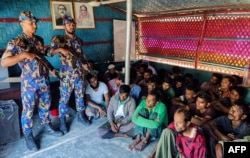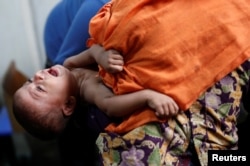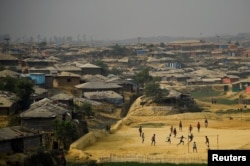Myanmar Rohingya refugees living in camps in Bangladesh and the aid agencies helping them are warning of more hunger, crime and death in the wake of new cuts to World Food Program rations.
The United Nations agency said a $125 million funding shortfall was forcing it to drop the value of its monthly food vouchers in the camps from $12 to $10 per head as of March 1.
This marks the first cut the WFP has made to the vouchers since 2017, when a brutal campaign of arson, rape and murder by the security forces of Buddhist-majority Myanmar drove more than three-quarters of a million mostly Muslim Rohingya into Bangladesh.
“This is a devastating blow to the Rohingya and an equally devastating blow to the humanitarian community,” WFP Country Director Domenico Scalpelli said in a statement announcing the move. “With other critical services already dwindling, the repercussions of the ration cut — even if just two dollars — will be dire.”
Malnutrition, he added, “will certainly rise.”
Besides the modest stipends some of the refugees earn working for non-government groups inside the camps, Bangladesh forbids them from paid employment, citing issues of law and order. Some slip in and out of the camps regardless to find paid work in nearby towns and villages. But refugees tell VOA that new fencing and stepped-up police checks are making that much tougher to do.
Mohammad Akmal Shareef, Bangladesh country director of Action Against Hunger, says that makes the WFP vouchers the main, and often, only source of food for the roughly 1 million Rohingya now living in the sprawling camps.
Like the WFP, he said cutting the vouchers would have “direct implications” on malnutrition.
“This means there will be a significant cut in terms of food, what we are supplying to each household, and it’s a matter of great concern,” he said. “Already when you had the $12, I think we were struggling to supply the quality food what I think these people deserve.”
Even with the vouchers at $12, the WFP says nearly half of all families in the camps are not eating enough and that malnutrition is “widespread.” According to the U.N. agency, some 40% of the children have stunted growth and 12% suffer from acute malnutrition.
“We say that if the malnourished children proportion is about 10% of your population, it is an emergency,” said Dr. Zahid Hassan Zihad, who helps run a group of clinics for malnourished children in the camps.
Zihad said the rate has dropped significantly in the five years since the clinics opened. But at 12%, “it is still an emergency,” he added, and could worsen in the wake of the cuts.
Refugees and aid groups say spiraling inflation makes the cuts feel deeper still.
“I feel so worried,” said one refugee, speaking on condition of anonymity for his safety.
He shared a recent month’s shopping list for his family of four using their vouchers: 52 kg of rice, 2 kg of chickpeas, 1 kg of flour, 21 eggs and a sack of onions, plus some cooking oil, garlic, salt and sugar.
“Right now, $12 per each one, it is ... not enough, so how can we feed [ourselves] by $10? So, it may be we need to face more difficulties,” he said. “Now most of the families are taking the decision not to eat two times per day rice.”
Human rights advocates and aid groups are warning that the cuts will lead to more looting, prostitution and child marriage as the refugees, barred from earning their living legally, try to make up for the shortfall any way they can.
“When there is pressure, as we have seen in previous responses in different places wherever there is a refugee crisis, people tend to go for more negative coping mechanisms,” said Akmal Shareef.
The refugees echoed those fears.
“If the ration amount is cut, I don’t know what the situation will look like in the refugee camps, because when a person could not [put] enough food in their stomach, then they will engage in bad activities. They will try to loot from others, they will try to do bad things to earn money because there is not any source of income,” said Kyaw Moe Thu, using an alias for fear of reprisal from local police for speaking out.
Rising levels of crime and despair in the camps are already driving a growing number of refugees to flee by boat for Malaysia or Indonesia, Muslim-majority countries where they hope to find work, an education and a husband or wife.
The U.N. says more than 3,500 Rohingya attempted the perilous sea journey from Bangladesh or Myanmar last year, the most since 2015. It estimates that roughly 1 in 10 of them went missing or died along the way, mostly from hunger or drowning; the boats they board tend to be in poor shape, often breaking down or capsizing in open water.
Despite the risks, Kyaw Moe Thu expects the dwindling rations to drive even more Rohingya across the sea.
“They know how hard the journey is, they know there is danger, there is risk during the way. But even knowing, they are going, because the situation in the camp is very, very rough,” he said.
In a statement of its own, Save the Children said the refugees need more support, not less. It called the funding shortfall forcing the WFP to cut its monthly rations “unconscionable” and urged donors to rethink their priorities to “prevent a hunger crisis.”
Without an “immediate funding boost,” the WFP says it may have to cut the rations a second time this year.
Akmal Shareef, of Action Against Hunger, says he cannot even image the impact a second cut would have.
“I don’t really want to think about that,” he said. “That will be a horrible situation.”
Shaikh Azizur Rahman contributed to this report.










